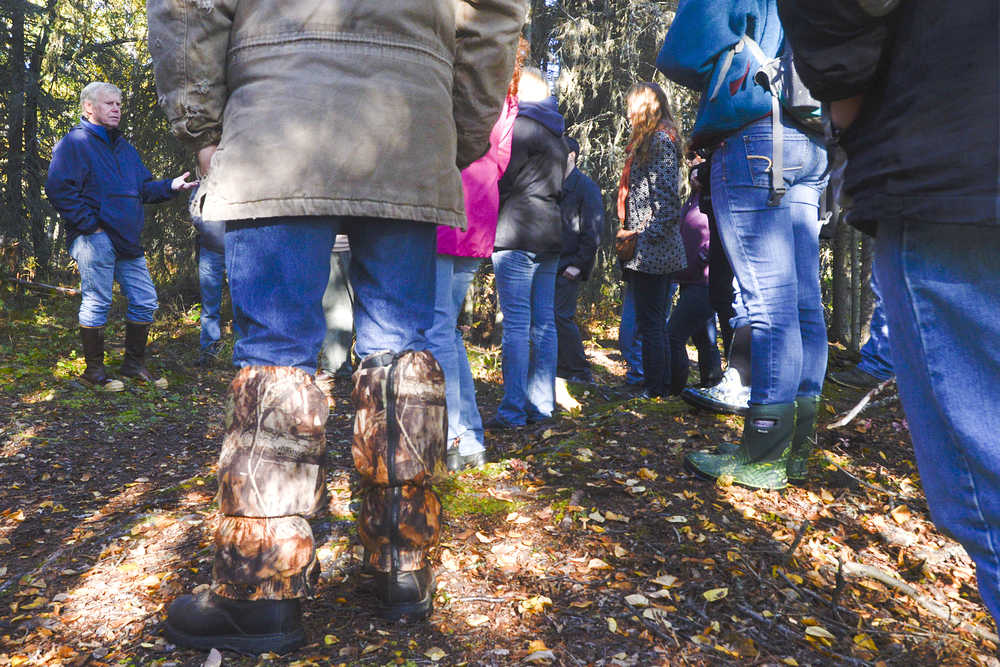Alan Boraas took 22 people for an hour-long walk through a thousand years of history Thursday in the woods near Kenai Peninsula College.
It’s a trip Boraas, a professor of anthropology at the college, makes three or four times a year; one he uses to show off some of the barely concealed prehistoric cultural heritage sites of the Dena’ina people who thrived on the Kenai Peninsula from about 1000 A.D. through the late 1700s when the Russians arrived.
“Had the Russians not come, the Americans not come, they would still be a sustainable culture based on salmon and other wild foods. (They would be) totally self-contained in the sense of being non-globalized. They were not dependent on other groups, they were not dependent on international trade, they were totally food sovereign,” Boraas said after the trip.
“So, food sovereignty is the point I was trying to get across to people and it’s not just the obtaining of the food, it’s having the social and spiritual practices that make you sovereign and sustainable.”
The field trip drove home several concepts discussed in the classroom, said freshman aviation business management student Merick Ahlberg.
“It makes it real,” Ahlberg said. “A lot of the stuff you hear, it’s like ‘that’s cool, but probably not really around here.’ Somebody discovered that on another continent. But this, it’s in our backyard.
“It’s there for us to find, he said. ”
Ahlberg, who grew up in the area, said he didn’t realize the sites existed until Boraas led the class to a narrow path that runs between College Road and Slikok Creek. The group eventually hiked down to the Kenai River before heading back to the campus buildings. Along the way, they passed 50 archaeological sites including housing depressions and underground cold storage pits the Dena’ina used to freeze and keep salmon over the winter.
Surprise is a common response to the hike, Boraas said. Typically, students tell him that, without the hike, they would have had no idea that the sites existed.
While the pits and housing depressions are easy to find, few other artifacts of Dena’ina existence are readily available, Boraas said.
The Dena’ina believed that artifacts and places absorbed information and carried the energy of an event, negative or positive, Boraas said.
So, people were careful about leaving artifacts around because the energy could potentially be damaging to the people exposed to it.
Boraas said he learned that concept the hard way.
“The first house I excavated in 1973, I think I got one artifact out of all those weeks of working,” he said.
The Dena’ina habit of leaving no trace is one Boraas said he hoped would hold significance for students.
“It’s sort of the opposite of the ethic of our modern society where we have this idea of making a difference, changing the world, innovating and all those sorts of things,” he said. “But hey didn’t do that and you wouldn’t if you were a very sustainable culture.”
Boraas said he hoped students would be able to come away from the class with a sense of pride in the Kenai Peninsula, that “they will see the place that many of them grew up, differently.”
In addition, he said, he wants them to question the elements of sovereignty.
“We are this globalized network,” he told the group as they stood on a trail near the Kenai River. “I’m not saying that’s a bad thing, just don’t embrace it and glorify it, because it’s also very delicate.”
Ahlberg said he saw at one thing he had in common with the Dena’ina people.
“Our family, we fish a lot and we store it in our freezers and eat it throughout the winter just like they would. We can, smoke and dry and hang a lot of it, so that kind of hit close to home. It’s a technique from centuries ago. The same idea and end result.”
Reach Rashah McChesney at rashah.mcchesney@peninsulaclarion.com

